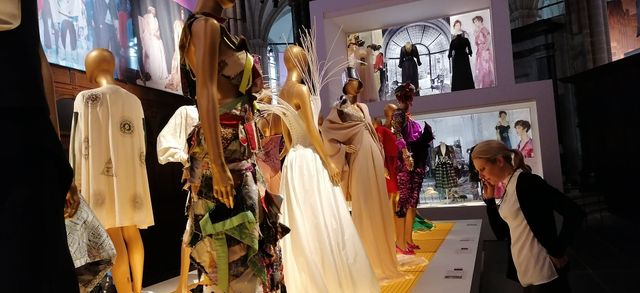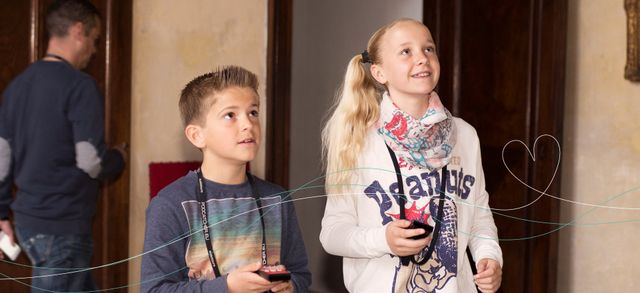A plea against smartphones in museums
Frits Polman • may 19, 2022
Image copyright © Guide-ID
My social media regularly features posts from companies that make apps for museums. Apps that promise heaven and earth, with the-sky-is-the-limit vibes. And to experience all this goodness, all you need is a smartphone. It’s a smartphone utopia for museums and visitors alike. However, now that I’m armed with a good two decades of experience in the museum sector, I feel it’s time to dissect those utopian promises.
I should start by saying I get what the developers of those apps are trying to achieve. Virtually everyone nowadays has a smartphone, so why not add ‘multimedia guide’ to its many functions? It would mean companies no longer have to invest millions in developing their own ‘players’, nor would they have to worry about the logistics of supplying and maintaining them. What is there not to like? And since everyone is glued to their smartphone all day anyway, it’s only natural that they would do the same in a museum setting. Right?
Detracting from the experience
However, that’s where the first mistake is made. Think about the last time you visited a museum. Why did you choose to visit? Probably because you wanted to see an exhibition and specific objects or works of art. You’d seen it all online, but now you wanted to experience it in real life – up close, letting your eyes wander over the painting, taking it all in. Bam! That’s the power of real, authentic art. Give me one good reason why you’d interrupt this magical event by picking up your phone to find out more about the art. You know how it goes: you’re on your phone, so you might as well check Facebook or answer that LinkedIn message.

Image copyright © Guide-ID
It’s become a familiar sight. People open their smartphone, their eyes fixate on the screen, and they drift off. They’re in a virtual world; the museum’s magic is lost. I think it shouldn’t be this way. Many of the museum apps contain an overwhelming amount of information. While this is fantastic if you’re at home or on the go, it’s a huge distraction when you’re physically at the museum. Standing in front of a piece of art, the most you want is a concise story about the work itself, and that story should be audio, so your eyes can stay focused on the work of art. You don’t need endless background information, information about other exhibitions, or complicated menu structures that you have to untangle before finding the information you want. You want to use your eyes to look at the art – not at your smartphone screen.
Waving your smartphone in the air
And then there’s the way content is activated. More and more companies are using automated image recognition: point your smartphone at a painting, and all the information pops up on your screen. It couldn’t be easier. But how do you know which painting has more information? Or will the museum provide information for every single object or work on display? If they don’t, and you point your smartphone at a piece of art but nothing happens, you’re likely to stop using the app. Besides that, I can’t help but see parallels between scanning paintings and what people often do at concerts nowadays: all waving their smartphone in the air in an attempt to film the performance. It’s not my idea of the perfect concert or museum visit.
Audio-only
I can hear you saying: ‘I get it, Frits. But the apps do offer something very practical – a map on your smartphone, so you don’t get lost.’ You’d be right, and I’d have to agree. If you’re afraid of getting lost and having to spend the night in the shadowy halls of the museum, I recommend downloading a map as soon as you walk through the doors. I’ll be clear about using smartphone screens for films and photos: when I first got into multimedia guides back in 2004, I also thought it was a fantastic idea. However, curators and museum staff kept reminding me that visitors have the most intense experience when they’re looking at the art rather than at a screen. That’s why we’ve been doing audio-only since 2009. Our success speaks for itself...

Image copyright © Guide-ID
Despite this, we also offer an app for smartphones and a mobile website. There are two reasons for this. The first: is self-protection. Some companies make it seem as if apps are the panacea to every single problem a museum might face. Sometimes, not having an app is enough for a prospective customer to reject you outright, leaving you no opportunity to paint a realistic picture. The second: comparing the use of our own app and mobile website with the Podcatcher (our flagship), we can provide data that shows the Podcatcher offers a better experience than a smartphone. That knowledge is a real eye-opener for museums.
Not for everyone
Finally, I’d like to comment on the scope of smartphone use in museums. Not all visitors have a smartphone – school groups are one example. And the visitors who do have one don’t always have the latest updates and technology. For example, our new Podcatcher uses Ultra-Wideband (UWB), so we can visualize accurate walking routes and provide the right information at the right times. However, this is only available from iPhone 13 (if Apple releases it for third parties). It can sometimes take years for the latest technology to catch on with the majority of museum visitors, not least because the average age of museum visitors is 50 plus. And then there’s the argument about your smartphone battery: who wants to be left with an empty phone after two hours at a museum?
Case closed
So, we’ve come full circle. It’s all about using technology to provide visitors with a magical moment in front of authentic objects and art without being distracted. For our customers, we compare the experience of visitors who use their smartphone with the experience of visitors who use the Podcatcher. Time and time again, we see that the best experience is the non-distancing experience. That’s exactly what we offer with the Podcatcher. Case closed...
List of Services
-
The Power of In-Person Connections: Why Meeting Our Clients Matters One of the things I love most about my role at Guide-ID is the chance to meet our clients in person. No two museums or cultural sites are the same, and every visit is an opportunity to learn, share insights, and see first-hand how our Podcatcher Pro audio tour device is making an impact. There’s something invaluable about stepping into an exhibition space, watching visitors engage with an interactive audio tour, and understanding the challenges and opportunities unique to each location. It’s in these moments that we can really help museums optimize their storytelling, making experiences more immersive, accessible, and engaging.The Power of In-Person Connections: Why Meeting Our Clients Matters
-
Unlocking Stories, Hands-Free: How Automatic Triggering Transforms Visitor Experiences Seamless storytelling made possible by the Guide ID Podcatcher Pro and cutting-edge technology.Unlocking Stories, Hands-Free: How Automatic Triggering Transforms Visitor Experiences
-
What Does It Take to Transform Museum Storytelling? Discover how Thomas Fikken, Guide-ID’s Business Development Manager, is reshaping the visitor experience with the Podcatcher Pro – where innovative audio technology meets the art of storytelling.What Does It Take to Transform Museum Storytelling?
-
Bringing Stories to Life: Guide-ID at PinchukArtCentre's La Biennale di Venezia Exhibition Since 2023, Guide-ID has had the privilege of working with the PinchukArtCentre, a vital museum of cultural significance in Kyiv, Ukraine.Bringing Stories to Life: Guide-ID at PinchukArtCentre's La Biennale di Venezia Exhibition
-
ChronoQuest: Unraveling History's Wild Adventures as Guide-ID's Fearless Business Manager! Buckle up for an exhilarating UK expedition! With Guide-ID’s top-notch audio guide solutions, I explored Cheddar Gorge’s beauty, delved into Beezeum’s captivating wonders, and soaked in the history of Portchester Castle, HMS Victory, and Hailes Abbey. The enchantment of Castell Coch left me breathless. Join me on this thrilling adventure!ChronoQuest: Unraveling History's Wild Adventures as Guide-ID's Fearless Business Manager!
-
Biblia Brugge Are you curious about what we can still learn from the Bible today? Then visit Biblia Brugge, the newly-opened Bible experience centre in the Major Seminary. You pass through long cloisters on your way before receiving a warm welcome at Biblia: ‘Take a seat and get ready for a spectacular journey.’ Once you’re comfortably seated, illustrator Klaas Verplancke’s animated film begins to play. You see various questions. Do you dare to be yourself? Do you dare to discover the unknown world? Do you dare to listen in silence? These challenging questions keep you on your toes for the rest of the visit.Biblia Brugge